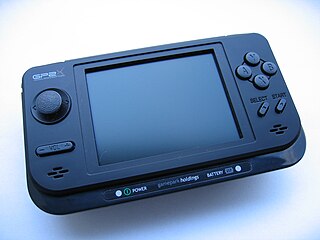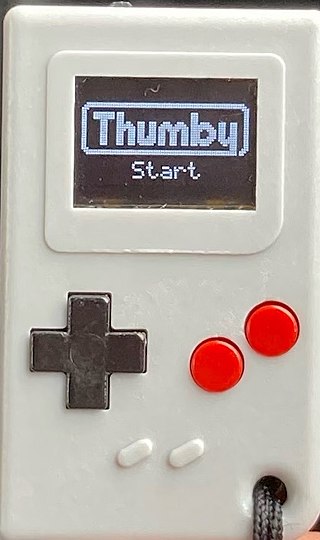
The Game Boy Advance (GBA) is a 32-bit handheld game console developed, manufactured, and marketed by Nintendo as the successor to the Game Boy Color. It was released in Japan on March 21, 2001, in North America on June 11, 2001, in the PAL region on June 22, 2001, and in mainland China as iQue Game Boy Advance on June 8, 2004.

A handheld game console, or simply handheld console, is a small, portable self-contained video game console with a built-in screen, game controls and speakers. Handheld game consoles are smaller than home video game consoles and contain the console, screen, speakers, and controls in one unit, allowing players to carry them and play them at any time or place.

Script Creation Utility for Maniac Mansion Virtual Machine (ScummVM) is a set of game engine recreations. Originally designed to play LucasArts adventure games that use the SCUMM system, it also supports a variety of non-SCUMM games by companies like Revolution Software and Adventure Soft. It was originally written by Ludvig Strigeus. ScummVM is free software that is released under the terms of the GNU General Public License.

The Tapwave Zodiac is a mobile entertainment console and personal digital assistant. Tapwave announced the system in May 2003 and began shipping in October of that same year. The Zodiac was designed to be a high-performance mobile entertainment system centered on video games, music, photos, and video for 18- to 34-year-old gamers and technology enthusiasts. By running an enhanced version of the Palm Operating System (5.2T), Zodiac also provided access to Palm's personal information management software and many other applications from the Palm developer community. The company was based in Mountain View, California.
VisualBoyAdvance is a free emulator of the Game Boy, Game Boy Color, and Game Boy Advance handheld game consoles as well as of Super Game Boy and Super Game Boy 2. It is still downloadable to this day.

The GP2X is a Linux-based handheld video game console and portable media player developed by South Korean company GamePark Holdings. It was released on November 10, 2005, in South Korea only.

The Pandora is a handheld gaming computer originally released in 2010. It is designed to take advantage of existing free and open-source software and to be a target for homebrew development. It is developed and produced by OpenPandora, which is made up of former distributors and community members of the GP32 and GP2X handhelds. Until 2013, multiple batches of slightly updated Pandora variants were produced. In 2014 the development of a redesigned and upgraded successor, called DragonBox Pyra, was started.

A video game console emulator is a type of emulator that allows a computing device to emulate a video game console's hardware and play its games on the emulating platform. More often than not, emulators carry additional features that surpass limitations of the original hardware, such as broader controller compatibility, timescale control, easier access to memory modifications, and unlocking of gameplay features. Emulators are also a useful tool in the development process of homebrew demos and the creation of new games for older, discontinued, or rare consoles.

The GP2X Wiz is a handheld game console and portable media player developed by South Korean company GamePark Holdings running a Linux kernel-based embedded operating system.

The Dingoo is a handheld gaming console that supports music and video playback and open game development. The system features an on-board radio and recording program. It was sold to consumers in three colors: white, black, and pink. It was released in February 2009 and had sold over 1 million units.

The GP2X Caanoo, more commonly known as Caanoo, stylized CAANOO, is an open source, Linux-based handheld video game console and portable media player developed by the South Korean company GamePark Holdings. It was released on August 16, 2010 in South Korea and was also sold throughout Europe. It is the successor to the GP2X Wiz, and was showcased at the Electronic Entertainment Expo 2010. The device's launch price was about US$150, which did not reach any retail stores in North America.

The Game Gadget is an open source gaming handheld that supports music and video playback, open game development, and some e-reader features.

The Neo Geo X (NGX) is a hybrid video game console manufactured by Tommo, licensed by SNK Playmore. Information about the Neo Geo X was first reported in January 2012 and later confirmed in March. It is the first Neo Geo system to be released since the discontinuation of the brand in 2004 and the third Neo Geo handheld console, following the 1999 release of the Neo Geo Pocket Color, which was supported until 2001.

The DragonBox Pyra is an upcoming Linux-based handheld computer equipped with a keyboard and gaming controls. The project entered prototyping stage in 2015. Pre-orders began on 1 May 2016, with a final release date still undefined. In August 2020 the first production model had been shipped, but only to developers, as the software wasn't ready.

The Arduboy is a handheld game console with open source software, based on the Arduino hardware platform.
The Anbernic RG351 is a Linux-based handheld game console created in China by Anbernic. The console uses a microSD card for storage and is a digital ROM-only console. It is the successor to the RG350, and has emerged as a prominent handheld console for retrogaming alongside the Retroid Pocket 2, with the screen aspect ratio of some models particularly optimized for Game Boy Advance titles. It is sold in several models with different shells and screen resolutions, but similar internal specifications. Critics have praised its quality and functionality, but criticized certain aspects of its design.

The Thumby is a small keychain-sized programmable game console produced by TinyCircuits of Akron, Ohio and funded by a Kickstarter campaign. The console measures 1.2 by 0.7 by 0.3 inches.

The Anbernic RG552 is a dual-boot Linux and Android-based handheld game console created in China by Anbernic. A retrogaming emulation console, it is the successor to the RG351, and is a larger console in general, about the size of a Nintendo Switch Lite. It has more powerful hardware and increased screen size in a 5:3 aspect ratio. Critics praised the system for its build quality, but criticized its price to performance ratio, saying that it would likely be eclipsed by other systems with increased emulation capabilities such as the Ayn Odin and Retroid Pocket 2+.
Anbernic is a Chinese manufacturer of handheld retrocomputing devices. These devices typically run a version of Android or Linux and allow users to play historical video games through software emulation.


















